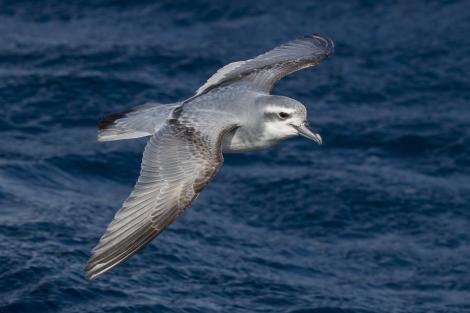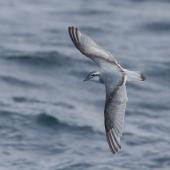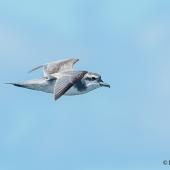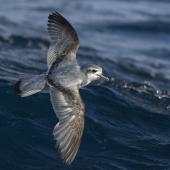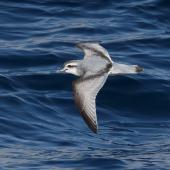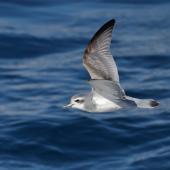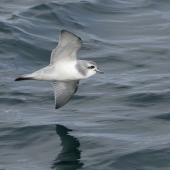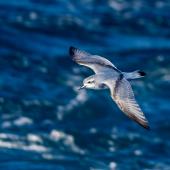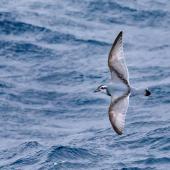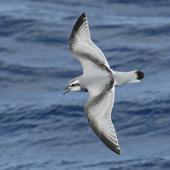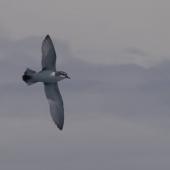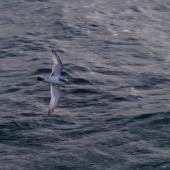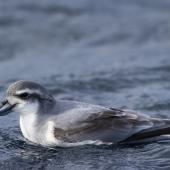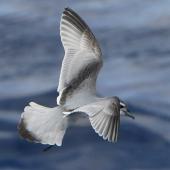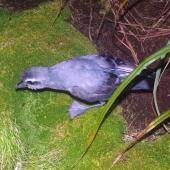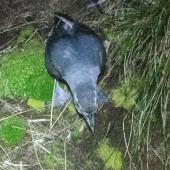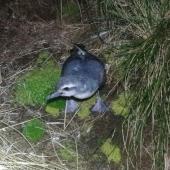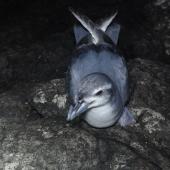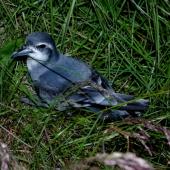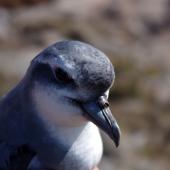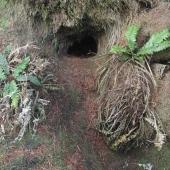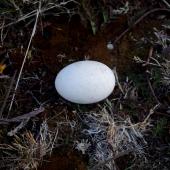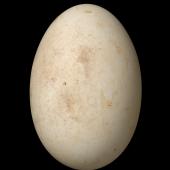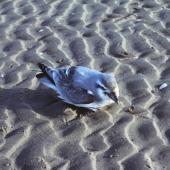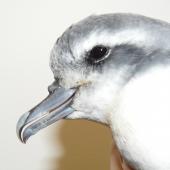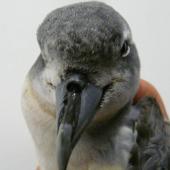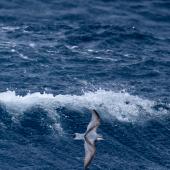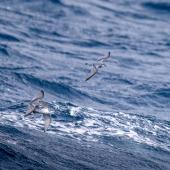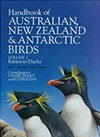Antarctic prion | Totorore
Pachyptila desolata (Gmelin, 1789)
Order: Procellariiformes
Family: Procellariidae
Other names: dove prion, whalebird
Geographical variation: No subspecies currently recognised.
The Antarctic prion is an abundant small seabird of Antarctic and subantarctic waters south of 50° south. They are very similar in appearance to the five other prion species: blue-grey and black above, and white below, with blue bill and legs. The main New Zealand breeding colonies are on the subantarctic Auckland Islands, but they breed at many other sites around the Southern Ocean, including an estimated 22 million pairs on South Georgia. Antarctic prions, along with other prion species, are often found storm-wrecked on beaches in late winter, especially on the west coast of the North Island.
Identification
All six prion species are very similar in appearance and behaviour, differing mainly in bill shape. All are medium-small seabirds that are blue-grey above and white below, with a blackish ‘M’ across the back from wingtip to wingtip, a black tip to the upper tail, blue-grey bill, and blue legs and feet.
Voice: prions rarely call at sea, but they are vocal on the ground at night at their breeding colonies, giving harsh chattering calls and softer dove-like crooning.
Similar species: the Antarctic prion is most similar in bill structure to Salvin’s prion, and the two also have very similar facial markings. The main characters used to distinguish them in the hand are that the Antarctic prion generally has a brighter blue bill with a larger nail at the tip, straighter sides to the bill when viewed from above, and lamellae (comb-like filters) not visible from the side when the bill is closed. In contrast, Salvin’s prion has a slightly larger grey-blue bill with relatively weaker nail, bowed sides to the bill when viewed from above, and lamellae visible when the bill is closed. Bill measurements of the two overlap (Salvin’s prion 13.5-17.5 mm wide; Antarctic prion 11-15.5 mm wide). Thin-billed prion has paler facial markings and a narrower bill (9.3-12.5 mm).
Distribution and habitat
Within the New Zealand region, Antarctic prions are known to breed only on the Auckland Islands, but they are likely to breed on outlying islands and stacks around Campbell Island. Elsewhere, they breed in vast colonies on South Georgia, and also on South Sandwich, South Orkney, South Shetland, Crozet, Kerguelen, Heard, and Macquarie Islands, and possibly at a few sites on the Antarctic continent. They nest in burrows under low forest or tussock, or in rock crevices. At sea, Antarctic prions mainly occur south of the Antarctic Convergence, including among pack-ice, north to 50° S south of New Zealand in summer. In winter they often wash ashore on west coast beaches as far north as Ninety Mile Beach, and occasionally on Raoul Island, Kermadec Islands, also east to Chatham Islands (including two birds caught at night there).
There are few claimed sightings of Antarctic prions off the New Zealand mainland, but this is partly due to the extreme difficulty of separating prion species at sea.
Population
The New Zealand population has not been surveyed, and is roughly estimated at between 100,000 and a million pairs. Breeding has been recorded from Auckland, Adams, Enderby, Ewing and Ocean Islands in the Auckland Island group, but is likely to occur on other islands there also (e.g. Disappointment and Rose Islands). The world population is many millions of pairs, with 22 million pairs estimated for South Georgia, and 2-3 million pairs at Kerguelen Islands.
Threats and conservation
Large numbers of Antarctic prions are killed by feral cats and pigs on Auckland Island. This species is expected to benefit from the 2001 eradication of Norway rats (and natural extinction of feral cats) on Campbell Island, and the 1993 eradication of rabbits (which compete for burrows) from Enderby and Rose Islands in the Auckland Islands. Eradication of cats and pigs on Auckland Island would be of enormous benefit to Antarctic prions, as well as many other seabird and landbird species. Antarctic prions are occasionally caught in nets used to catch squid near the Auckland Islands.
Breeding
Not studied in New Zealand. On Signy Island, South Orkney Islands, Antarctic prions breed in large colonies. They return in late October, lay in mid to late December, and the young depart from mid March to early April. Like other prions and petrels, the adults are monogamous and share incubation and chick care. Incubation of the single white egg takes 44-46 days, and chicks fledge at 45-55 days old.
Behaviour and ecology
Antarctic prions often occur in large flocks at sea, sometimes mixed with blue petrels and other prion species. They are generally not attracted to boats, but will fly alongside large vessels. Food items are mainly captured by shallow dives or surface-seizing while hydroplaning – facing into the wind with wings extended, and dipping the head and neck into the upper 10 cm of the water column.
Antarctic prions visit breeding sites after dark and depart before dawn, or stay in burrows or nest crevices during daylight. Large numbers are killed by subantarctic skuas. Flocks disperse widely around the Southern Ocean after breeding.
Food
Antarctic prions mainly eat small pelagic crustaceans, along with small squid, fish and gastropods.
Websites
References
Imber, M.J. 1994. Seabirds recorded at the Chatham Islands, 1960 to May 1993. Notornis (supplement) 41: 97-108.
Jamieson, S.E.; Tennyson, A.J.D.; Wilson, K.-J.; Crotty, E.; Miskelly, C.M.; Taylor, G.A.; Waugh, S.M. 2016. A review of the distribution and size of prion (Pachyptila spp.) colonies throughout New Zealand. Tuhinga 27: 56-80.
Marchant, S.; Higgins, P.J. (eds.), 1990. Handbook of Australian, New Zealand and Antarctic birds. Vol 1, ratites to ducks. Oxford University Press, Melbourne.
Onley, D.; Scofield, P. 2007. Field guide to the albatrosses, petrels and shearwaters of the world. Christopher Helm and A&C Black Publishers Ltd, London.
Powlesland, R.G. 1989. Seabirds found dead on New Zealand beaches in 1986 and a review of Pachyptila recoveries since 1960. Notornis 36: 125-140.
Shirihai, H. 2007. A complete guide to Antarctic wildlife: the birds and marine mammals of the Antarctic continent and the Southern Ocean. 2nd edn. A & C Black, London.
Taylor, G.A. 2000. Action plan for seabird conservation in New Zealand, Part B: Non-threatened seabirds. Threatened Species Occasional Publication 17. Department of Conservation, Wellington.
Tickell, W.L.N. 1962. The dove prion, Pachyptila desolata Gmelin. Falkland Islands Dependencies Survey scientific report no. 33, 55 pp.
Recommended citation
Miskelly, C.M. 2013 [updated 2023]. Antarctic prion | totorore. In Miskelly, C.M. (ed.) New Zealand Birds Online. www.nzbirdsonline.org.nz
Antarctic prion | Totorore
- Breeding season
-
- Jul
- Aug
- Sep
- Oct
- Nov
- Dec
- Jan
- Feb
- Mar
- Apr
- May
- Jun
- Egg laying dates
-
- Jul
- Aug
- Sep
- Oct
- Nov
- Dec
- Jan
- Feb
- Mar
- Apr
- May
- Jun




